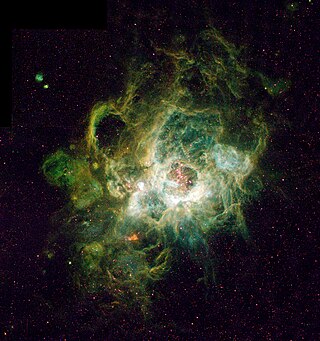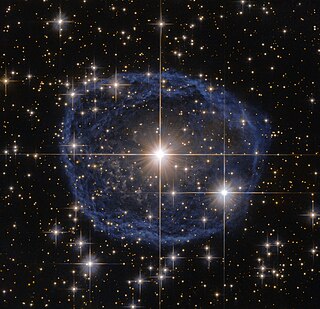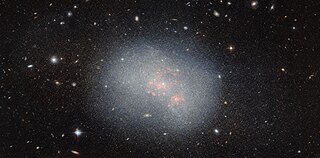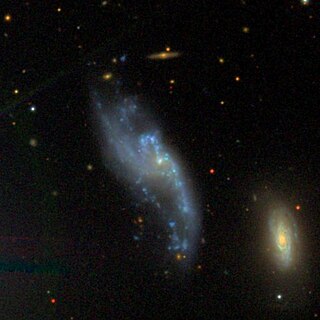
Seyfert galaxies are one of the two largest groups of active galaxies, along with quasar host galaxies. They have quasar-like nuclei with very high surface brightnesses whose spectra reveal strong, high-ionisation emission lines, but unlike quasars, their host galaxies are clearly detectable.

An H II region or HII region is a region of interstellar atomic hydrogen that is ionized. It is typically in a molecular cloud of partially ionized gas in which star formation has recently taken place, with a size ranging from one to hundreds of light years, and density from a few to about a million particles per cubic centimetre. The Orion Nebula, now known to be an H II region, was observed in 1610 by Nicolas-Claude Fabri de Peiresc by telescope, the first such object discovered.

Wolf–Rayet stars, often abbreviated as WR stars, are a rare heterogeneous set of stars with unusual spectra showing prominent broad emission lines of ionised helium and highly ionised nitrogen or carbon. The spectra indicate very high surface enhancement of heavy elements, depletion of hydrogen, and strong stellar winds. The surface temperatures of known Wolf–Rayet stars range from 20,000 K to around 210,000 K, hotter than almost all other kinds of stars. They were previously called W-type stars referring to their spectral classification.

A starburst galaxy is one undergoing an exceptionally high rate of star formation, as compared to the long-term average rate of star formation in the galaxy, or the star formation rate observed in most other galaxies.

The Centaurus A/M83 Group is a complex group of galaxies in the constellations Hydra, Centaurus, and Virgo. The group may be roughly divided into two subgroups. The Cen A Subgroup, at a distance of 11.9 Mly, is centered on Centaurus A, a nearby radio galaxy. The M83 Subgroup, at a distance of 14.9 Mly, is centered on the Messier 83 (M83), a face-on spiral galaxy.

NGC 3603 is a nebula situated in the Carina–Sagittarius Arm of the Milky Way around 20,000 light-years away from the Solar System. It is a massive H II region containing a very compact open cluster HD 97950.

NGC 2366 is a Magellanic barred irregular dwarf galaxy located in the constellation Camelopardalis.

A Pea galaxy, also referred to as a Pea or Green Pea, might be a type of luminous blue compact galaxy that is undergoing very high rates of star formation. Pea galaxies are so-named because of their small size and greenish appearance in the images taken by the Sloan Digital Sky Survey (SDSS).

WR 134 is a variable Wolf-Rayet star located around 6,000 light years away from Earth in the constellation of Cygnus, surrounded by a faint bubble nebula blown by the intense radiation and fast wind from the star. It is five times the radius of the sun, but due to a temperature over 63,000 K it is 400,000 times as luminous as the Sun.

Tololo 1247-232 is a small galaxy at a distance of 652 million light-years. It is situated in the southern equatorial constellation of Hydra. Visually, Tol 1247 appears to be an irregular or possibly a barred spiral galaxy. Tol 1247 is named after the surveys that were carried at the Cerro Tololo Inter-American Observatory (CTIO), the first of which was in 1976. It is one of nine galaxies in the local universe known to emit Lyman continuum photons.

Haro 11 (H11) is a small galaxy at a distance of 300,000,000 light-years (redshift z=0.020598). It is situated in the southern constellation of Sculptor. Visually, it appears to be an irregular galaxy, as the ESO image to the right shows. H11 is named after Guillermo Haro, a Mexican astronomer who first included it in a study published in 1956 about blue galaxies. H11 is a starburst galaxy that has 'super star clusters' within it and is one of nine galaxies in the local universe known to emit Lyman continuum photons (LyC).

WR 31a, commonly referred to as Hen 3-519, is a Wolf–Rayet (WR) star in the southern constellation of Carina that is surrounded by an expanding Wolf–Rayet nebula. It is not a classical old stripped-envelope WR star, but a young massive star which still has some hydrogen left in its atmosphere.

NGC 1614 is the New General Catalogue identifier for a spiral galaxy in the equatorial constellation of Eridanus. It was discovered on December 29, 1885 by American astronomer Lewis Swift, who described it in a shorthand notation as: pretty faint, small, round, a little brighter middle. The nebula was then catalogued by Danish-Irish astronomer J. L. E. Drayer in 1888. When direct photography became available, it was noted that this galaxy displayed some conspicuous peculiarities. American astronomer Halton Arp included it in his 1966 Atlas of Peculiar Galaxies. In 1971, Swiss astronomer Fritz Zwicky described it as a "blue post-eruptive galaxy, compact patchy core, spiral plumes, long blue jet SSW".

NGC 5238 is an irregular galaxy in the constellation Canes Venatici. Located at a comoving distance of 4.51 Mpc, it is 64.4 arcseconds in diameter. It has sometimes been classified as a blue compact dwarf galaxy. Although some authors have hypothesized it to be a member of the M101 Group of galaxies, it is currently believed to be an isolated galaxy.

NGC 541 is a lenticular galaxy located in the constellation Cetus. It is located at a distance of about 230 million light years from Earth, which, given its apparent dimensions, means that NGC 541 is about 130,000 light years across. It was discovered by Heinrich d'Arrest on October 30, 1864. It is a member of the Abell 194 galaxy cluster and is included in the Atlas of Peculiar Galaxies in the category galaxies with nearby fragments. NGC 541 is a radio galaxy of Fanaroff–Riley class I, also known as 3C 40A.

PHL 293B, also known as Kinman's dwarf, is a low-metallicity blue compact dwarf galaxy about 22.6 Mpc from the Earth in the constellation Aquarius.
NGC 6822-WR 12 is a WN-type Wolf-Rayet star located in the galaxy NGC 6822, about 1.54 million light years away in the constellation of Sagittarius. NGC 6822-WR 12 was the first Wolf-Rayet star to be discovered in the galaxy, and is one of only four known in the galaxy.

NGC 2445 is a peculiar ring galaxy in the constellation Lynx. The galaxy lies about 200 million light years away from Earth, which means, given its apparent dimensions, that NGC 2445 is approximately 100,000 light years across. It was discovered by Édouard Stephan on January 18, 1877. The galaxy interacts with another galaxy, NGC 2444, and as a result its shape is distorted and new stars are formed.

NGC 3995 is a Magellanic spiral galaxy in the constellation Ursa Major. The galaxy lies about 100 million light years away from Earth based on the Tully–Fisher relation, which means, given its apparent dimensions, that NGC 3995 is approximately 80,000 light years across, while based on redshift it lies 170 million light years away. It was discovered by Heinrich d'Arrest on February 5, 1864.

PKS 1402-012, also known as UM 632, is a quasar located in the constellation of Virgo. With a redshift of 2.51, the object is located 10.7 billion light-years from Earth.



















